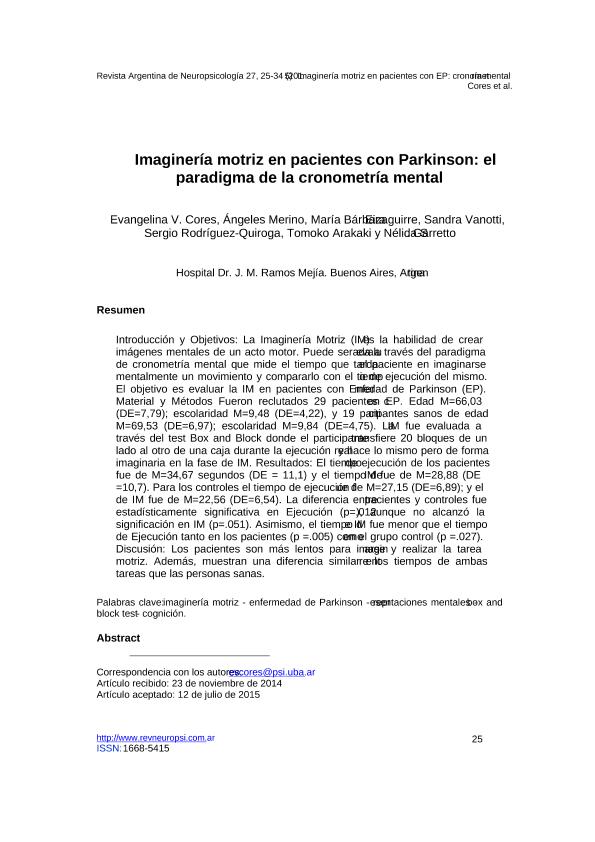Mostrar el registro sencillo del ítem
dc.contributor.author
Cores, Evangelina Valeria

dc.contributor.author
Merino, Ángeles
dc.contributor.author
Eizaguirre, María Bárbara
dc.contributor.author
Vanotti, Sandra

dc.contributor.author
Rodríguez Quiroga, Sergio Alejandro

dc.contributor.author
Arakaki, Tomoko

dc.contributor.author
Garreto, Nélida Susana

dc.date.available
2018-08-27T13:59:55Z
dc.date.issued
2015-07
dc.identifier.citation
Cores, Evangelina Valeria; Merino, Ángeles; Eizaguirre, María Bárbara; Vanotti, Sandra; Rodríguez Quiroga, Sergio Alejandro; et al.; Imaginería motriz en pacientes con Parkinson: el paradigma de la cronometría mental; Sociedad Latinoamericana de Neuropsicología; Revista Argentina de Neuropsicología; 27; 7-2015; 25-34
dc.identifier.issn
1668-5415
dc.identifier.uri
http://hdl.handle.net/11336/57146
dc.description.abstract
Introducción y Objetivos: La Imaginería Motriz (IM) es la habilidad de crear imágenes mentales de un acto motor. Puede ser evaluada a través del paradigma de cronometría mental que mide el tiempo que tarda el paciente en imaginarse mentalmente un movimiento y compararlo con el tiempo de ejecución del mismo. El objetivo es evaluar la IM en pacientes con Enfermedad de Parkinson (EP). Material y Métodos Fueron reclutados 29 pacientes con EP. Edad M=66,03 (DE=7,79); escolaridad M=9,48 (DE=4,22), y 19 participantes sanos de edad M=69,53 (DE=6,97); escolaridad M=9,84 (DE=4,75). La IM fue evaluada a través del test Box and Block donde el participante transfiere 20 bloques de un lado al otro de una caja durante la ejecución real y hace lo mismo pero de forma imaginaria en la fase de IM. Resultados: El tiempo de ejecución de los pacientes fue de M=34,67 segundos (DE = 11,1) y el tiempo de IM fue de M=28,88 (DE =10,7). Para los controles el tiempo de ejecución fue de M=27,15 (DE=6,89); y el de IM fue de M=22,56 (DE=6,54). La diferencia entre pacientes y controles fue estadísticamente significativa en Ejecución (p=.012), aunque no alcanzó la significación en IM (p=.051). Asimismo, el tiempo de IM fue menor que el tiempo de Ejecución tanto en los pacientes (p =.005) como en el grupo control (p =.027). Discusión: Los pacientes son más lentos para imaginarse y realizar la tarea motriz. Además, muestran una diferencia similar entre los tiempos de ambas tareas que las personas sanas.
dc.description.abstract
Introduction and Objective: Motor Imagery (MI) is the ability to create mental representations of a motor act. It can be assessed trough the mental chronometry paradigm, in which the time it takes to make a movement by a patient is recorded and then compared to the time it takes to actually performed it. The aim is to assessed MI in patients with Parkinson’s disease (PD). Materials and Method: Twenty nine patients with PD were recruited, age M=64.68 (SD=9,1), education M=28,88 (DE =10,7), and 19 healthy participants, age M=64,68 (SD=6,97); education M=9,84 (SD=4,75). The MI was assessed trough the Box and Block test were participants must transfer 20 blocks from one side of a box to the other in the execution phase and the same movement mentally in the MI phase. Results: The execution time of patients was M=34,67 seconds (SD = 11,1) and the MI time was M=28,88 (SD =10,7). For the control group execution time was M=27,15 (SD=6,89) and the MI time was M=22,56 (SD=6,54). Difference between patients and controls were significant in the execution phase, (p=.012), although in MI the difference did not reach statistical significance (p=.051). Meanwhile, MI time was lower than execution time in both patients (p =.005) and controls (p =.027). Discussion: Patients with PD are slower in the imagination and in the real performance of a movement. Also, they show a similar difference between the times of both conditions than healthy participants.
dc.format
application/pdf
dc.language.iso
spa
dc.publisher
Sociedad Latinoamericana de Neuropsicología
dc.rights
info:eu-repo/semantics/openAccess
dc.rights.uri
https://creativecommons.org/licenses/by-nc-sa/2.5/ar/
dc.subject
Imaginería Motriz
dc.subject
Enfermedad de Parkinson
dc.subject
Representaciones Mentales
dc.subject
Cognición
dc.subject
Box And Block Test
dc.subject.classification
Salud Ocupacional

dc.subject.classification
Ciencias de la Salud

dc.subject.classification
CIENCIAS MÉDICAS Y DE LA SALUD

dc.title
Imaginería motriz en pacientes con Parkinson: el paradigma de la cronometría mental
dc.type
info:eu-repo/semantics/article
dc.type
info:ar-repo/semantics/artículo
dc.type
info:eu-repo/semantics/publishedVersion
dc.date.updated
2018-08-16T18:07:57Z
dc.journal.volume
27
dc.journal.pagination
25-34
dc.journal.pais
Argentina

dc.journal.ciudad
Ciudad Autónoma de Buenos Aires
dc.description.fil
Fil: Cores, Evangelina Valeria. Consejo Nacional de Investigaciones Científicas y Técnicas; Argentina. Gobierno de la Ciudad de Buenos Aires. Hospital General de Agudos "Ramos Mejía"; Argentina
dc.description.fil
Fil: Merino, Ángeles. Gobierno de la Ciudad de Buenos Aires. Hospital General de Agudos "Ramos Mejía"; Argentina
dc.description.fil
Fil: Eizaguirre, María Bárbara. Gobierno de la Ciudad de Buenos Aires. Hospital General de Agudos "Ramos Mejía"; Argentina
dc.description.fil
Fil: Vanotti, Sandra. Gobierno de la Ciudad de Buenos Aires. Hospital General de Agudos "Ramos Mejía"; Argentina
dc.description.fil
Fil: Rodríguez Quiroga, Sergio Alejandro. Gobierno de la Ciudad de Buenos Aires. Hospital General de Agudos "Ramos Mejía"; Argentina
dc.description.fil
Fil: Arakaki, Tomoko. Gobierno de la Ciudad de Buenos Aires. Hospital General de Agudos "Ramos Mejía"; Argentina
dc.description.fil
Fil: Garreto, Nélida Susana. Gobierno de la Ciudad de Buenos Aires. Hospital General de Agudos "Ramos Mejía"; Argentina
dc.journal.title
Revista Argentina de Neuropsicología
dc.relation.alternativeid
info:eu-repo/semantics/altIdentifier/url/http://www.revneuropsi.com.ar/images/stories/pdf/coresranps27.pdf
Archivos asociados
